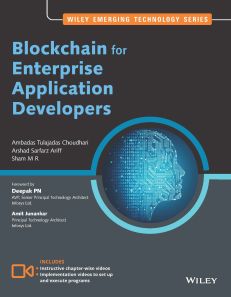Blockchain for Enterprise Application Developers
ISBN: 9788126599967
336 pages
Publication Year: 2020
For more information write to us at: acadmktg@wiley.com

Description
Blockchain for Enterprise Application Developers tries to touch various aspects in blockchain space, from understanding what it is, how to design solutions, how to build prototypes and where the landscape is heading. Two popular blockchain platforms – Ethereum and Hyperledger – are explained and utilized in this book, mainly due to popularity and relevance for enterprise use cases, respectively. Significant focus has also been made on enterprise use cases where current technologies are already solving the problems in the domain in certain way.
Dedication
Foreword
Preface
About the Authors
Acknowledgements
Chapter 1 Introduction
1.1 Introduction
1.2 Scenarios
1.3 Challenges Articulated
1.4 What is Blockchain?
1.5 Blockchain Characteristics
1.6 Opportunities Using Blockchain
1.7 History of Blockchain
1.8 Skillsets Requirements
Chapter 2 Evolution of Blockchain
2.1 Evolution of Computer Applications
2.2 Centralized Applications
2.3 Decentralized Applications
2.4 Stages in Blockchain Evolution
2.5 Consortia
2.6 Restrictions on Sharing Ledgers
2.7 Forks
2.8 Public Blockchain Environments
2.9 Type of Players in Blockchain Ecosystem
2.10 Players in Market
Chapter 3 Blockchain Concepts
3.1 Introduction
3.2 Chaining of Blocks
3.3 Hashing
3.4 Merkle Tree
3.5 Consensus
3.6 Mining and Finalizing Blocks
3.7 Currency Aka Tokens
3.8 Security on Blockchain
3.9 Data Storage on Blockchain
3.10 Wallets
3.11 Coding on Blockchain: Smart Contracts
3.12 Peer-to-Peer Network
3.13 Types of Blockchain Nodes
3.14 Risk Associated with Blockchain Solutions
3.15 Life Cycle of Blockchain Transaction
Chapter 4 Architecting Blockchain Solutions
4.1 Introduction
4.2 Obstacles for Use of Blockchain
4.3 Blockchain Relevance Evaluation Framework
4.4 Blockchain Solutions Reference Architecture
4.5 Types of Blockchain Applications
4.6 Cryptographic Tokens
4.7 Typical Solution Architecture for Enterprise Use Cases
4.8 Types of Blockchain Solutions
4.9 Architecture Considerations
4.10 Architecture with Blockchain Platforms
4.11 Approach for Designing Blockchain Applications
Chapter 5 Ethereum Blockchain Implementation
5.1 Introduction
5.2 Tuna Fish Tracking Use Case
5.3 Ethereum Ecosystem
5.4 Ethereum Development
5.5 Ethereum Tool Stack
5.6 Ethereum Virtual Machine
5.7 Smart Contract Programming
5.8 Integrated Development Environment
5.9 Truffle Framework
5.10 Ganache
5.11 Unit Testing
5.12 Ethereum Accounts
5.13 MyEtherWallet
5.14 Ethereum Networks/Environments
5.15 Infura
5.16 Etherscan
5.17 Ethereum Clients
5.18 Decentralized Application
5.19 Metamask
5.20 Tuna Fish Use Case Implementation
5.21 OpenZeppelin Contracts
5.22 Best Practices for Ethereum Smart Contract Development
Chapter 6 Hyperledger Blockchain Implementation
6.1 Introduction
6.2 Use Case – Car Ownership Tracking
6.3 Hyperledger Fabric
6.4 FabCar Use Case Implementation
6.5 Invoking Chaincode Functions Using Client Application
6.6 Best Practices for Chaincode Development
Chapter 7 Advanced Concepts in Blockchain
7.1 Introduction
7.2 InterPlanetary File System (IPFS)
7.3 Zero-Knowledge Proofs
7.4 Oracles
7.5 Self-Sovereign Identity
7.6 Blockchain with IoT and AI/ML
7.7 Quantum Computing and Blockchain
7.8 Initial Coin Offering
7.9 Blockchain Cloud Offerings
7.10 Blockchain and its Future Potential
Conclusion
Chapter Recap
Chapter Mind Map
Test Yourself
Assignments
References
Internet References
Possible Interview Questions and Answers
Glossary
Bibliography
Index

